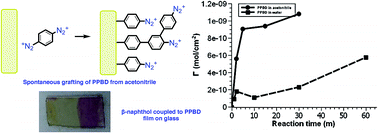Diazonium-functionalized thin films from the spontaneous reaction of p-phenylenebis(diazonium) salts†
Abstract
Salts of the diazonium coupling agent p-phenylenebis(diazonium) form diazonium-terminated conjugated thin films on a variety of conductive and nonconductive surfaces by spontaneous reaction of the coupling agent with the surface. The resulting diazonium-bearing surface can be reacted with various organic and inorganic nucleophiles to form a functionalized surface. These surfaces have been characterized with voltammetry, XPS, infrared and Raman spectroscopy, and atomic force microscopy. Substrates that can be conveniently and quickly modified with this process include ordinary glass, gold, and an intact, fully assembled commercial screen-printed carbon electrode. The scope and convenience of this process make it promising for practical surface modification.



 Please wait while we load your content...
Please wait while we load your content...